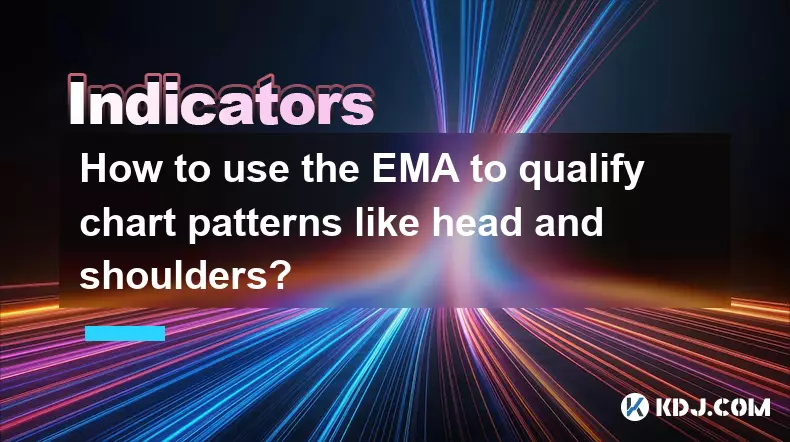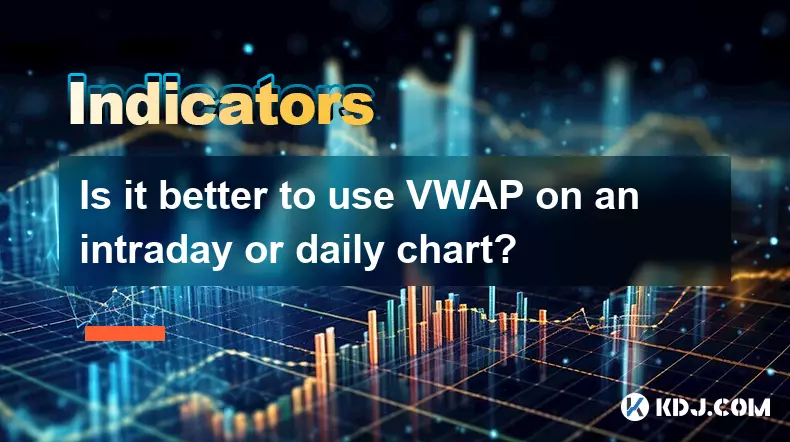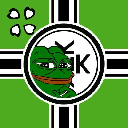-
 bitcoin
bitcoin $108842.957301 USD
-1.88% -
 ethereum
ethereum $3931.777121 USD
-1.66% -
 tether
tether $1.000186 USD
-0.03% -
 bnb
bnb $1153.250882 USD
-2.20% -
 xrp
xrp $2.367904 USD
-1.94% -
 solana
solana $186.182050 USD
-4.20% -
 usd-coin
usd-coin $0.999997 USD
0.00% -
 tron
tron $0.316949 USD
-1.00% -
 dogecoin
dogecoin $0.190780 USD
-3.12% -
 cardano
cardano $0.651324 USD
-2.67% -
 hyperliquid
hyperliquid $37.141055 USD
-0.85% -
 ethena-usde
ethena-usde $0.999224 USD
-0.09% -
 chainlink
chainlink $17.579031 USD
-2.47% -
 bitcoin-cash
bitcoin-cash $509.426284 USD
-2.79% -
 stellar
stellar $0.315298 USD
-2.93%
How to use the EMA to qualify chart patterns like head and shoulders?
The EMA helps confirm head and shoulders reversals in crypto by showing weakening momentum, especially when price breaks below the 50 or 200 EMA during the right shoulder formation.
Oct 14, 2025 at 08:00 am

Understanding EMA in the Context of Chart Patterns
1. The Exponential Moving Average (EMA) is a type of moving average that places greater weight on recent price data, making it more responsive to new information compared to the Simple Moving Average (SMA). In cryptocurrency trading, where volatility is high and trends can shift rapidly, EMA provides timely signals for potential reversals or continuations. When analyzing chart patterns such as head and shoulders, traders use EMA to confirm the strength or weakness of the prevailing trend.
2. Head and shoulders patterns are classic reversal formations consisting of three peaks: a left shoulder, a higher central peak (the head), and a right shoulder that mirrors the left in height. The neckline connects the lows between these peaks. A break below the neckline typically signals a bearish reversal. By overlaying EMAs—commonly the 50-period and 200-period—on the same chart, traders assess whether the price is respecting or violating key dynamic support and resistance levels aligned with the pattern.
3. For instance, during the formation of the left shoulder, if the price remains above the 50 EMA, it suggests underlying bullish momentum. As the head forms and surpasses prior highs, continued trade above the rising EMA reinforces the uptrend. However, when the right shoulder develops and fails to reach the height of the head while simultaneously dipping below the 50 EMA, this divergence highlights weakening momentum—a critical clue that the head and shoulders structure may culminate in a breakdown.
Using EMA Crossovers to Validate Pattern Completion
1. Traders often watch for EMA crossovers in conjunction with head and shoulders developments. A bearish crossover occurs when a shorter-term EMA, like the 9 or 13 period, crosses below a longer-term EMA such as the 26 or 50. If this crossover happens near the completion of the right shoulder or immediately after a neckline breach, it strengthens the validity of the bearish signal.
2. In fast-moving crypto markets, false breakdowns are common. A drop below the neckline that doesn’t coincide with EMA confirmation might be a trap. Conversely, a breakdown supported by a concurrent EMA crossover reduces the likelihood of a fakeout. This dual confirmation increases confidence in short entries or exit strategies for long positions.
3. On the flip side, if the price breaks below the neckline but quickly rebounds above both the neckline and the 50 EMA, especially if the shorter EMA recrosses above the longer one, the head and shoulders pattern may fail. Such resilience indicates persistent buying pressure, invalidating the bearish setup.
Dynamic Support and Resistance from EMA During Pattern Formation
1. During the evolution of a head and shoulders pattern, EMAs act as dynamic support levels in an uptrend. If each pullback in the left shoulder and head phases finds support at or near the 50 EMA, this demonstrates consistent demand. The inability of the right shoulder to bounce from the same level—especially if price closes below it—signals erosion of support.
2. A decisive close beneath the 200 EMA during the right shoulder phase significantly enhances the bearish implications of the pattern. The 200 EMA is widely followed across the crypto community and often acts as a long-term trend filter. Its violation suggests a broader shift in market sentiment, aligning with the structural breakdown implied by the head and shoulders.
3. Volume analysis combined with EMA behavior adds another layer. Declining volume on the formation of the head and increased selling volume during the descent from the right shoulder, particularly when accompanied by EMA breakdowns, supports the legitimacy of the reversal pattern.
Practical Application in Crypto Markets
1. In Bitcoin’s 2021 cycle, a prominent head and shoulders pattern emerged after the $64,000 peak. Throughout the left shoulder and head phases, price held above the 50 and 200 EMAs on weekly charts. The right shoulder formed with lower highs and multiple closes below the 50 EMA, followed by a confirmed break under the neckline. The concurrent drop below the 200 EMA added strong technical validation to the bearish case.
2. Altcoins often mirror Bitcoin’s macro patterns with amplified volatility. A head and shoulders formation on Ethereum, for example, was reinforced when the 13 EMA crossed below the 48 EMA during the right shoulder decline. This intraday signal provided early warning before the neckline break, allowing traders to position ahead of the broader market recognition.
3. Scalpers and swing traders apply EMA filtering differently. While long-term traders focus on daily or weekly EMAs, shorter-term operators use 15-minute or hourly EMA alignments to time exits during the right shoulder’s failure to retest prior highs. Tight confluence between price action, EMA rejection, and volume spikes improves execution precision.
Frequently Asked Questions
What EMA periods are most effective when analyzing head and shoulders patterns?The 50 and 200 EMAs are most commonly used due to their significance in identifying intermediate and long-term trends. The 50 EMA helps track momentum during the pattern’s development, while the 200 EMA serves as a benchmark for overall trend integrity. Shorter periods like 9 and 21 can assist in timing entries during breakdowns.
Can a head and shoulders pattern be valid if the price stays above the EMA?It is unlikely. If the price remains consistently above key EMAs like the 50 or 200 during the right shoulder formation, it indicates sustained buying interest. This contradicts the loss of momentum required for a true reversal. A valid bearish pattern typically includes clear EMA rejection or breakdown.
How does EMA help distinguish between a head and shoulders and a continuation pattern?EMA slope and positioning provide context. In a continuation pattern like a flag or pennant, EMAs remain sloped in the direction of the trend and act as support. In a genuine head and shoulders, the EMA flattens or turns downward during the right shoulder, reflecting stalled momentum and increasing distribution.
Disclaimer:info@kdj.com
The information provided is not trading advice. kdj.com does not assume any responsibility for any investments made based on the information provided in this article. Cryptocurrencies are highly volatile and it is highly recommended that you invest with caution after thorough research!
If you believe that the content used on this website infringes your copyright, please contact us immediately (info@kdj.com) and we will delete it promptly.
- Dogecoin's Wild Ride: Market Turmoil and Price Decline Explained
- 2025-10-17 18:25:12
- XRP Price, 2030 Prediction, Crypto Presale: Decoding the Future
- 2025-10-17 18:25:12
- Bubblemaps, ChainOpera, and COAI Profits: A Deep Dive into the BNB Ecosystem
- 2025-10-17 18:30:13
- BlockchainFX: Chasing 100x Gains in Crypto Presales
- 2025-10-17 18:30:13
- From Hack to Jackpot: How a $20 Coin (Not Really, But Close!) Became a Million-Dollar Treasure
- 2025-10-17 18:35:12
- Ethereum's Wobble and the Rise of IPO Genie: A Safe Haven in Crypto?
- 2025-10-17 18:35:12
Related knowledge

What's the main difference between VWAP and TWAP?
Oct 12,2025 at 11:54am
Understanding VWAP and Its Role in Crypto Trading1. Volume Weighted Average Price (VWAP) is a trading benchmark that calculates the average price of a...

How do you identify exhaustion moves using VWAP and its bands?
Oct 12,2025 at 08:00am
Understanding the Role of Decentralized Exchanges in Crypto Trading1. Decentralized exchanges (DEXs) operate without a central authority, allowing use...

Is it better to use VWAP on an intraday or daily chart?
Oct 15,2025 at 02:01am
Intraday Trading and the Role of VWAP1. Intraday traders frequently rely on VWAP (Volume Weighted Average Price) as a dynamic benchmark for assessing ...

How do you use VWAP to scale in and out of positions?
Oct 14,2025 at 02:19am
Understanding VWAP as a Dynamic Benchmark1. The Volume Weighted Average Price (VWAP) is not just an indicator—it functions as a dynamic benchmark that...

What are the main advantages of using VWAP over EMA?
Oct 11,2025 at 02:18am
Main Advantages of Using VWAP Over EMA1. Volume-Weighted Average Price (VWAP) incorporates trading volume into its calculation, offering a more accura...

How do you use VWAP on different chart types like Heikin Ashi?
Oct 11,2025 at 05:01pm
Understanding VWAP in the Context of Heikin Ashi Charts1. The Volume Weighted Average Price (VWAP) is a powerful analytical tool commonly used by trad...

What's the main difference between VWAP and TWAP?
Oct 12,2025 at 11:54am
Understanding VWAP and Its Role in Crypto Trading1. Volume Weighted Average Price (VWAP) is a trading benchmark that calculates the average price of a...

How do you identify exhaustion moves using VWAP and its bands?
Oct 12,2025 at 08:00am
Understanding the Role of Decentralized Exchanges in Crypto Trading1. Decentralized exchanges (DEXs) operate without a central authority, allowing use...

Is it better to use VWAP on an intraday or daily chart?
Oct 15,2025 at 02:01am
Intraday Trading and the Role of VWAP1. Intraday traders frequently rely on VWAP (Volume Weighted Average Price) as a dynamic benchmark for assessing ...

How do you use VWAP to scale in and out of positions?
Oct 14,2025 at 02:19am
Understanding VWAP as a Dynamic Benchmark1. The Volume Weighted Average Price (VWAP) is not just an indicator—it functions as a dynamic benchmark that...

What are the main advantages of using VWAP over EMA?
Oct 11,2025 at 02:18am
Main Advantages of Using VWAP Over EMA1. Volume-Weighted Average Price (VWAP) incorporates trading volume into its calculation, offering a more accura...

How do you use VWAP on different chart types like Heikin Ashi?
Oct 11,2025 at 05:01pm
Understanding VWAP in the Context of Heikin Ashi Charts1. The Volume Weighted Average Price (VWAP) is a powerful analytical tool commonly used by trad...
See all articles










































































